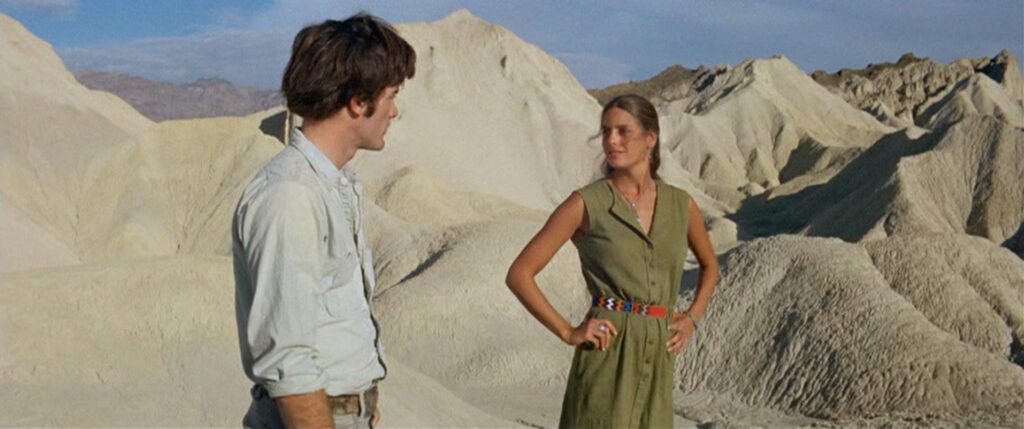
Zabriskie Point
1970, directed by Michelangelo Antonioni
At the end of Zabriskie Point, Daria flees from the desert house near Phoenix, unwilling to continue her job with a real estate developer after hearing of Mark’s death on the radio. Before she drives off into the sunset, she stops to turn and stare at the house, a deluxe modern dwelling built into a rock outcropping. She imagines the house exploding in a giant fireball, first at normal speed then again and again, in slow motion and room by room, various contents of civilization blowing up more or less in sequence – food, clothing, furniture, and appliances. The last thing she explodes in her mind, accentuated by a loud drum roll and a series of primal screams, is the one thing that must go before her imaginative destruction is complete – books.
One of Antonioni’s hallmarks, if it can be separated from his overall attention to quality, is the particular care he takes with his endings. Each of his films builds to an ending that’s not calculated for dramatic effect, but rather which is totally appropriate to the rest of the movie. These explosions therefore need to be seen in the whole context of Zabriskie Point. The destruction of books does not have a positive record in history, nor for that matter do exploding buildings, but Daria shows no hatred nor wish for tyranny. Her rebellion, rather, is a specific wish to change the direction of a civilization that overvalues abstraction and has forgotten the value of direct experience.
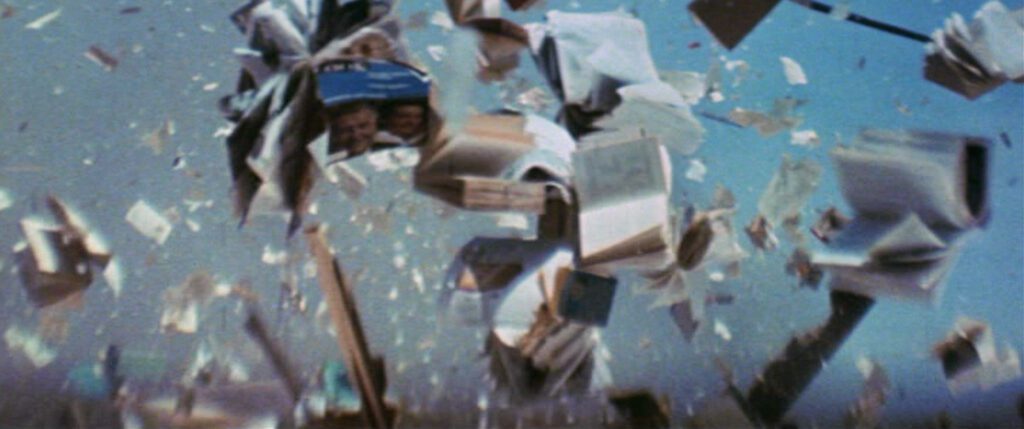
Daria’s symbolic destruction of books is another expression of Mark’s final gesture before returning the airplane and getting shot by police. He had repainted the pink plane with a colorful array of visual and verbal jokes (“she-he-it” doubles as a drawled-out version of “shit”) along with two slogans on the port and starboard sides: “No War” and “No Words”. The first should require no explanation, especially during the Vietnam War which the U.S. was waging in 1970, whereas the second summarizes the entire spirit of Zabriskie Point. Daria’s fantasy of exploding books is not iconoclastic or anti-intellectual – like Mark she’s fed up with a society that bombards us with abstract signs at the expense of real life.
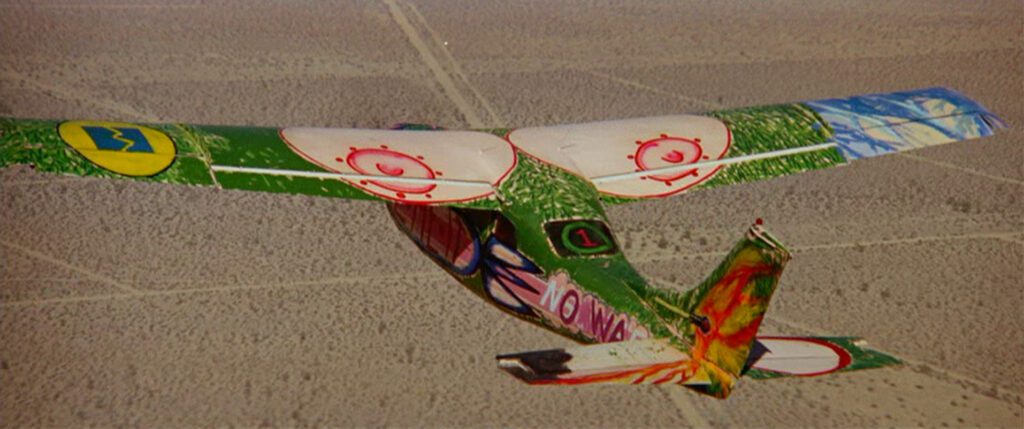
The profusion of signs throughout Zabriskie Point is staggering, yet it’s an accurate enough portrait of the United States that it doesn’t necessarily seem remarkable. Mark’s drive to campus with his roommate begins as a montage of billboards, murals, and street signs. From there on, the movie shows signs at every possible opportunity – billboards around the airport, logos on buildings and vehicles, wall signs, road signs, product labels and ads in the deli, inscriptions on oil drums and t-shirts, the gag sign in the desert bar (“In case of fire raise this flap.” “Not now stupid! In case of fire.”). When Mark drives by a pair of cops he flashes the peace sign and changes it to an extended middle finger. Even wordless symbols like the U.S. flag, mannequins in the real estate commercial, or the oversized gas station mascot add to the overwhelming saturation of signs. Anyone familiar with the American landscape must recognize that the movie needn’t go far out of its way to include all these signs – most films shot on real locations in the United States have to make a conscious effort to reduce such clutter.
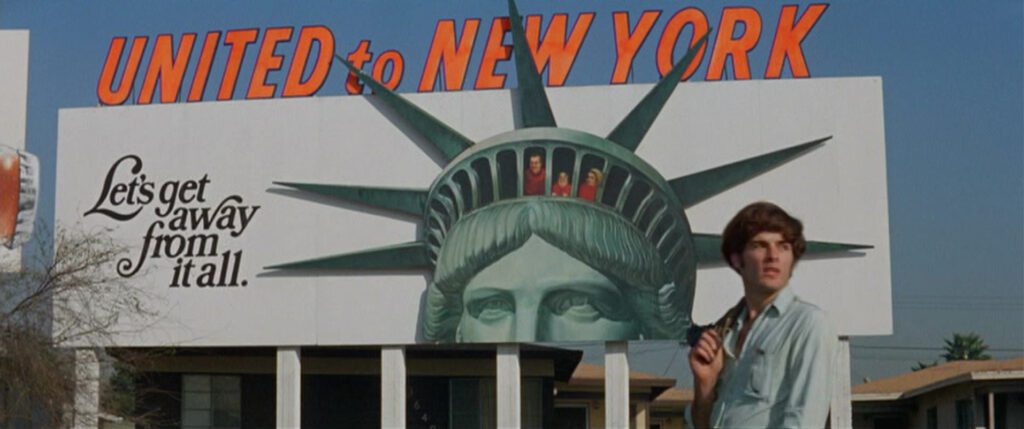
When the movie enters the desert it’s a relief from the ugliness of signs, but even there humans leave signs as their mark. Daria writes a message in the sand after Mark buzzes her; Zabriskie Point is marked by a National Park Service informational sign; and tourists drive up with souvenir decals plastered all over their camper window.
Zabriskie Point opens with a meeting of radical college students planning a strike. There are few visible signs or written words there, but most of the scene’s friction stems from the gap between words and action, and Mark leaves in frustration, singling out the meeting itself as a mass of words. Mark’s complaint is easy to make, but the movie’s portrait of the meeting goes deeper. The whole scene is a montage of individuals clamoring for recognition. They talk over each other, interrupt, and shout, while the polite ones raise their hands with an almost comic urgency. The flurry of logos and advertisements after the meeting is a seamless continuation of the radical students’ quest for attention.
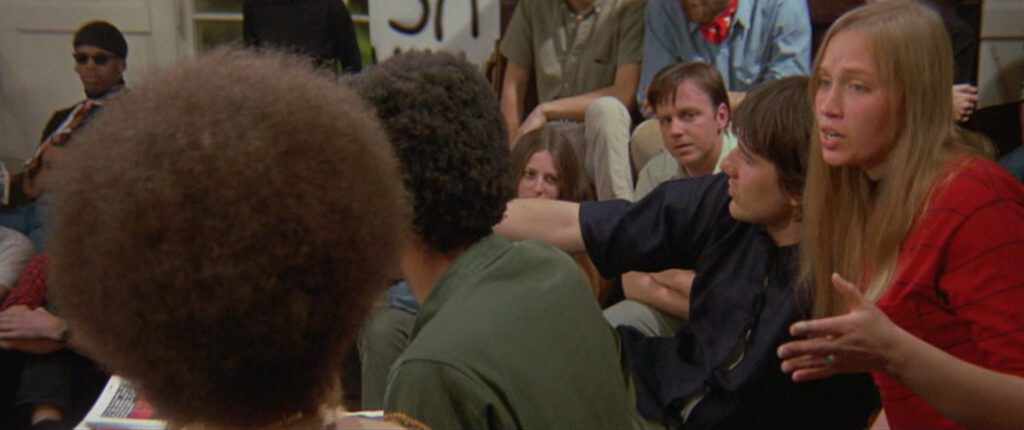
As Antonioni’s only portrait of the United States, Zabriskie Point represents an outsider’s perspective of a country lost in a sea of competing words. If all these words were rich with meaning it would be another story, but most of them are desperate cries for acknowledgment. Looking back from the age of social media, we can see that the picture is not only still relevant, it has spread across the globe. The Los Angeles setting points implicitly to Hollywood, which has always been a global evangelist for the notion that everyone should want to be a star.
The enslavement to words and signs that characterizes both the student meeting and the Los Angeles landscape pervades the larger society, from business to personal life, spanning all generations. Ultimately it results in an atomized society whose progress is held back by selfishness. We see it in the commercials for Sunny Dunes, in the emotionally disturbed children who surround Daria in the desert village, and in the elderly boxing champion Johnny Wilson who can only talk about himself. We can see its results in two forms of racism: white liberals romanticizing the black experience (We can be revolutionaries too!), and the white gun vendor sharing his customers’ fear of blacks. The business meeting at the end differs only superficially from the student meeting at the beginning – both are people throwing words at each other to get their way, and Daria leaves one meeting with the same disgust that drove Mark from the other.
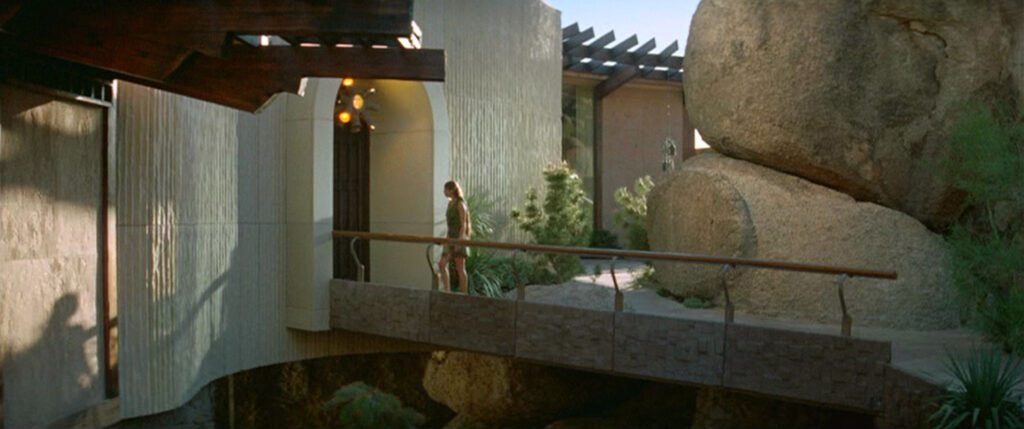
Only in the open desert and the skies above it do people escape this atomization and come together, connecting with each other and with their surroundings. Mark’s aerial courtship of Daria is not only an exciting act of romance, it’s also a relief from the wordiness and abstraction the movie has immersed us in. At Zabriskie Point they make love, and an imaginary crowd of young people fills the valley echoing their lovemaking in a kind of dream orgy. It’s not so much a picture of sex as a picture of social harmony on a grand scale – what the world might feel like if people let go of their addiction to abstractions.
Daria and Mark arrive at Zabriskie Point almost exactly halfway through the film, and they meet at the bottom of the valley less than four minutes later, almost precisely at the hour mark. From these metrics we can guess that the film is carefully structured, and its various symmetries form a kind of loose palindrome – the journey from civilization to Zabriskie Point and back, the parallels between the student meeting and the business meeting, and the two shootings by police (on the college campus and at the airport). Although the badlands of Zabriskie Point are not below sea level, the site belongs to Death Valley which includes the lowest point in America, making the movie a symbolic journey deep into the United States.
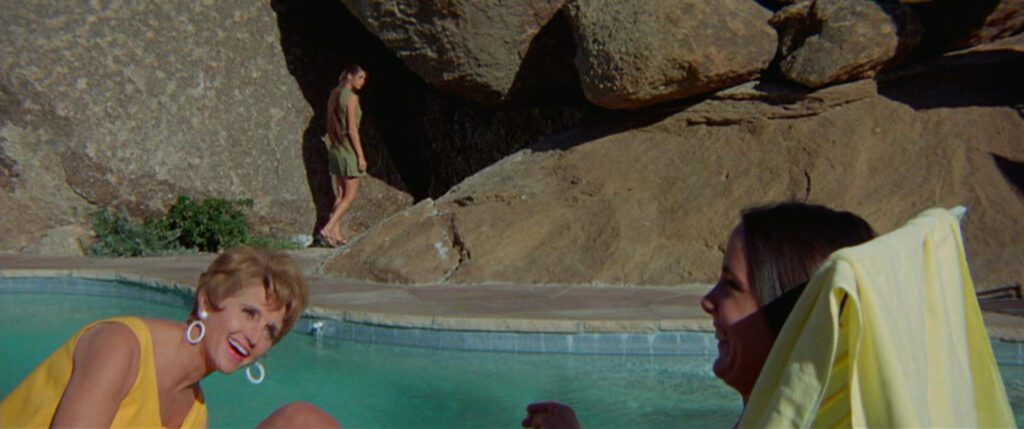
The argument in Zabriskie Point is more specific than a vague complaint against words. The problem with the words and other abstractions that dominate American civilization is that they’re designed to direct our attention, and in so doing they distract our vision from the people and world around us. Like most of Antonioni’s films it’s about the problem of seeing clearly. The student radicals are so preoccupied with being heard that they fail to listen to each other. Citizens of a consumer society become numb to the advertisements surrounding them and lose the ability to make their own decisions. On a deeper level, the dominant role of words in modern culture makes it difficult to see clearly to the essence of things. Civilization strips people of the ability to look at the world with wonder.
Also typical of Antonioni, and consistent with his disregard for the clamor of words and signs, the movie lays a groundwork for emotional experience without trying to direct our emotions the way most movies do through their dramatics. When Daria first hears of Mark’s death on her car radio, instead of breaking down she gets out and simply sways in the wind like the cactuses around her. Not only is her reaction more realistic than an overt display of emotion, it also opens space for the viewer to experience unfamiliar emotions that prepare for the experience of the final scene.
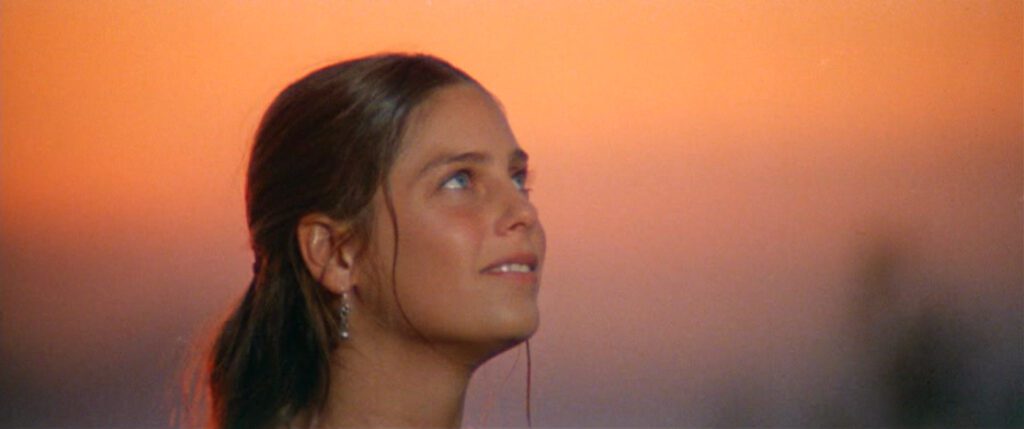
When Daria leaves the desert house at the end, it’s not the capitalism or her employer that immediately precipitates her exit. She turns to leave right after coming face to face with a Native American woman working as a servant. She looks at the woman with a warmth of recognition as if she senses a kindred soul, someone else with a connection to nature who’s trapped in a society that’s out of touch with nature. Daria’s vision of the house and its contents exploding shows a wish not for violence but for a return to nature. Her journey to Zabriskie Point has taught her what the movie hopes to show, that nature still offers us the conditions for stripping away abstraction, allowing us to connect with each other and to experience the world not through the intermediaries of words and signs, but directly and vividly.
CONNECTIONS:
Day of Wrath – Harmful or corrupting power of words; contrast between words and nature
Mildred Pierce – Set in Los Angeles with an implicit allusion to Hollywood’s social influence
L’eclisse – Distinction between two almost opposite kinds of racism
Alphaville – Argument against abstraction; similarity of vending machine & gag sign jokes; emotion saved for the end
Simón of the Desert – Begins and ends with atomized groups of individuals
The Man Who Left His Will on Film – Critique of radical youths’ preference for abstraction over life in 1970; made with unprofessional actors
Blade Runner – Set in Los Angeles with an implicit allusion to Hollywood’s social influence; profusion of billboards and advertisements; argument for experience over abstraction
The Sacrifice – Ends with the fiery destruction of a house; argument for action over words; words are the last item blown up (in Daria’s vision) or given up (in Alexander’s prayer)
Matchstick Men – Set in Los Angeles with an implicit allusion to Hollywood’s social influence